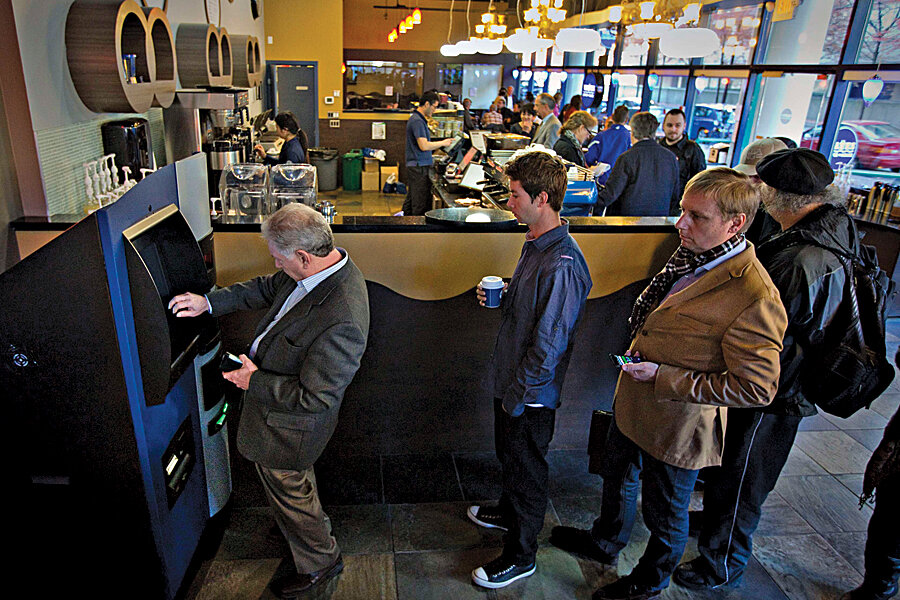Bitcoin ATM debuts in the US: What you need to know
Loading...
Bitcoin has had a rough go of it in 2014, battling volatile value fluctuations, a cyberattack that halted withdrawals from two major Bitcoin exchanges, and credibility problems, including the arrest of a prominent Bitcoin exchange CEO for money laundering.
However, Las Vegas-based company Robocoin is putting its faith in the future of the currency. On Tuesday it announced it will be releasing two new Bitcoin ATMs in the United States in this month.
But will this be enough to get Bitcoin past its recent troubles? Read on for everything you need to know about the new Bitcoin ATMs, from what they will look like to what obstacles they face in becoming as widely adopted as a regular, cash ATM:
What is a Bitcoin ATM?
Bitcoin is a virtual currency and peer-to-peer payment system, used mostly for online transactions. A Bitcoin ATM is a machine that lets users buy, sell, and convert bitcoins into cash without going online.
Will these be the first Bitcoin ATMs?
Only in the United States. Last October, Robocoin installed the world’s first Bitcoin ATM in a coffee shop in Vancouver. In its first 29 days, the ATM processed over $1,006,550 (CAD) from 1,576 transactions.
Does it work just like my favorite neighborhood ATM?
Short answer: no. Here’s the long answer. When you walk up to the blue and white machine, instead of inserting a debit card, you offer a government-issued ID (or your palm if you’re visiting the Vancouver location), which the machine reads and then directs to withdrawal and deposit options. From there, you can “swap bitcoin for cash, or deposit cash to buy more Bitcoin by transferring funds to or from a virtual wallet on your smart phone” according to Reuters. However, the machine takes a five percent transaction fee (far higher than online exchanges) and the Vancouver location employs a human assistant to work with customers navigating the machine.
What can I withdraw from Robocoin?
You can either convert dollars to Bitcoin in your virtual wallet, which is confirmed through the machine by printing a QR code receipt, or withdraw cash from your Bitcoin wallet (if you already have an account). This video sums it up pretty well.
Why would I use an ATM? Aren’t there online exchanges?
Yes, but with in-person ATMs, users don't need to go through the online verification process, which can sometimes take up to a few days. This way, Bitcoin exchanges can be done faster than ever before. However, the machine is still working out its kinks, and customers at the first Bitcoin ATM in Vancouver have occasionally had to wait a few hours for their transaction to go through. Other customers have been able to immediately confirm Bitcoin exchanges and make purchases right away.
Speaking of, where can I use Bitcoin these days?
To start, Waves, the coffee shop that houses the Vancouver ATM, accepts Bitcoin, though no word yet on whether the retail establishments that hold Robocoin machines in Seattle or Austin will accept the currency. Recently, Overstock and TigerDirect announced they would accept the online currency. Other companies that accept Bitcoin range from Zynga, the online gaming company, to blogging website Wordpress to Tesla Motors to Ok Cupid (for premium services).
Are there plans for more Bitcoin ATMs?
That could depend on Bitcoin's performance in the near future. The online currency seems to be at a bit of a crossroads. After hitting its all time highest value in December of over $1,200 per Bitcoin, the currency has rapidly fluctuated over the past few weeks. Two major Bitcoin exchanges, Mt. Gox and Bitstamp, briefly halted transactions in the past two weeks, after a denial-of-service attack created fake transaction confirmations, which sent the currency into a value tailspin (it is currently valued at about $620). Though Robocoin ATMs could help restore peoples’ confidence in the currency, already there has been lag in the rollout A planned second Canadian Bitcoin ATM, in Calgary, was heavily delayed. Last year, Robocoin’s CEO said there would be ATMs in major US cities such as New York City and Los Angeles by this January, but so far the only announced locations are the rollouts in Seattle and Austin later this month.








